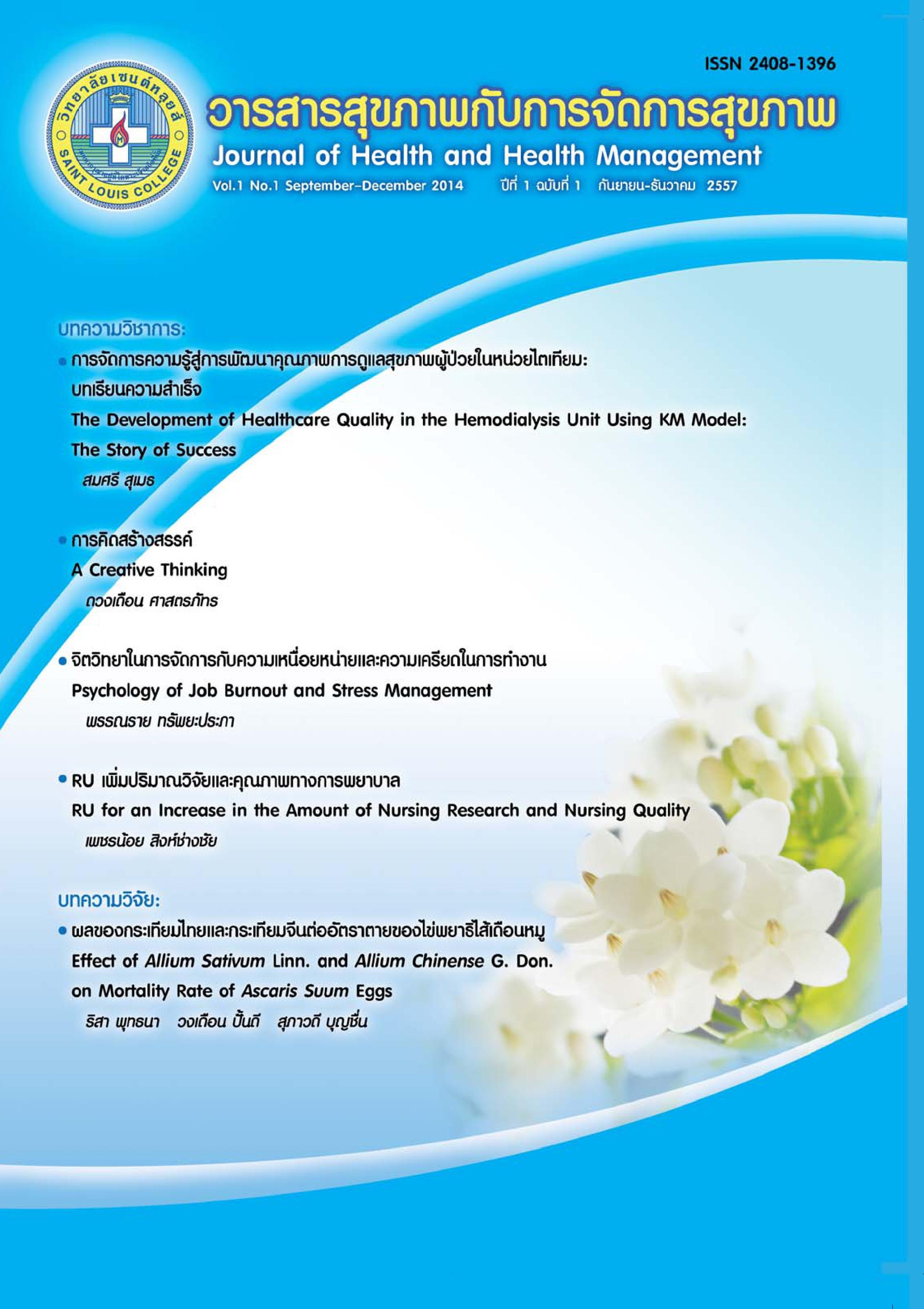Effect of Allium Sativum Linn. and Allium Chinense G. Don. on Mortality Rate of Ascaris Suum Eggs
Keywords:
Allium sativum Linn, Allium chinense G.Don, mortality rate, Ascaris suum infective eggsAbstract
Ascariasis is still a major public health problem in many countries around the world. There was a report which found that garlic could destroy Ascaris eggs. This study, using true experimental 2x5 factorial as its research design, aimed at studying the effect of concentration and type of garlic on mortality rate of Ascaris infective eggs. The study was conducted with Ascaris eggs in Thai and Chinese garlic at 5 concentration levels including 5%, 10%, 15%, 20% and 25%. The Ascaris eggs were counted on the date of 2, 3, 5, 7, 10, 14, 18, 21, 24, 28, 35, 42, 49, 56 and 63 post exposure to five concentrations of garlic. The data were analyzed by t-test and ANOVA. The results revealed that both concentration and type of garlic had an effect on mortality rate of A. suum infective eggs. There was an interaction between type and concentration of garlic in terms of the mortality rate of A. suum infective eggs increased when the concentration of garlic increased and it was higher in Thai garlic. Therefore, the mortality rate of A. suum infective eggs depended on concentrations and types of garlic.
References
บารมี สวัสดีมงคล. (2531). การมีชีวิตอยู่ของพยาธิ ไส้เดือนกลมหมูในกระเทียมดอง ต้นหอมดอง กิมจิ และผักกาดดองเค็ม. (วิทยานิพนธ์ปริญญา วิทยาศาสตรมหาบัณฑิต, มหาวิทยาลัยมหิดล).
ประเสริฐ ทองเจริญ. (2007). กระเทียม [special article]. Buddhachinaraj Medical Journal, 24(1), น. 88-92.
ร่วมฤดี พานจันทร์, พงษ์กฤษณ์ ศิริสรณ์ และสมวิทย์ ผาพรม. (2553). ฤทธิ์ของสารสกัดจากกระเทียมต่อการ ยับยั้งเชื้อแบคทีเรีย Aeromonas hydrophila ที่แยกได้จากปลาดุกลูกผสม. การประชุมทาง วิชาการของมหาวิทยาลัยเกษตรศาสตร์ ครั้งที่ 48, น. 329-335.
วิฑูรย์ ไวยนันท์ และพีรพรรณ ตันอารีย์. (2540). ปรสิตวิทยาทางการแพทย์ (Medical parasitology). พิมพ์ครั้งที่ 3. กรุงเทพฯ: ศักดิ์โสภาการพิมพ์. วารสารวงการแพทย์
วารสารวงการยา. (2557). กระเทียม สมุนไพรมหัศจรรย์. Retrieved from:https:// www.facebook.com/permalink.php? story_fbid=250294591746716&id=238 489546260554
Centers for Disease Control and Prevention. (2010). Parasite-Ascariasis. Retrievedfrom: http:// www.cdc.gov/parasites/ascariasis/.
Jia, T.W., Melville, S., Utzinger, J., King, C.H. & Zhou X.N. (2012). Soil-transmitted helminth reinfection after drug treatment: a systematic review and meta-analysis. PLoS Negl Trop Dis, 6(5), p.e1621.
Leles, D., Gardner, S.L., Reinhard, K., Iniguez, A. & Araujo A. (2012). Are Ascaris lumbricoides and Ascaris suum a single species?. Parasite Vectors, 5, p. 42.
Lima, C.M., et al. (2011). Ultrastructural study on the morphological changes to male worms of Schistosoma mansoni after in vitro exposure to allicin. Rev Soc Bras Med Trop, 44 (3), pp. 327-330.
Markell, E.K., John, D.T. & Krotoki, W.A. (1999). Markell and Voge’s medical parasitology 8th ed. Philadelphia: W.B.Saunders.
Muller, R. & Wakelin, D. (2001). Worm and human disease 2nd ed. London: Cabi publishing.




